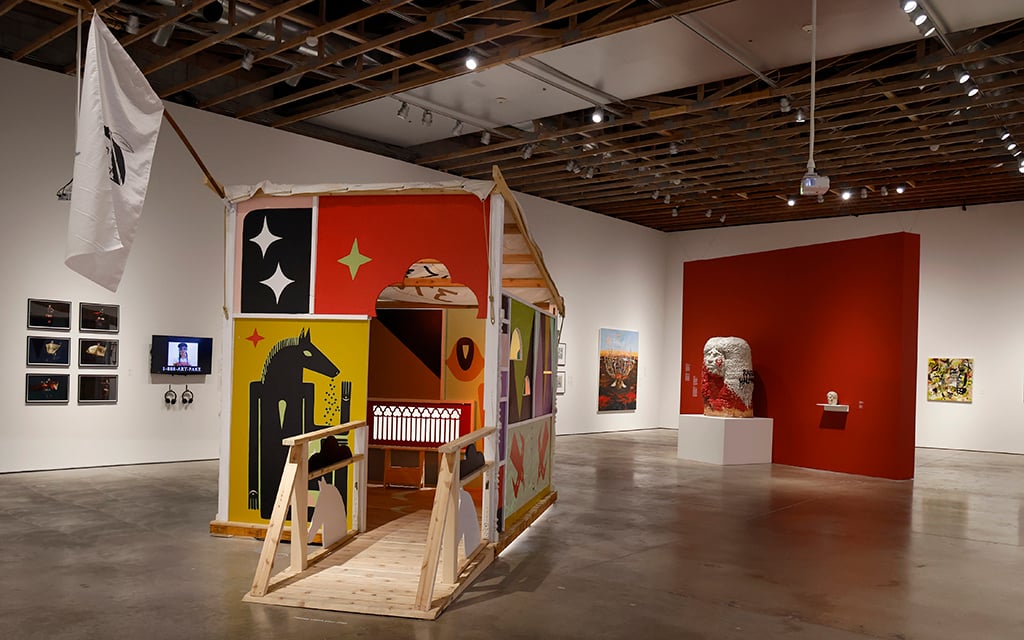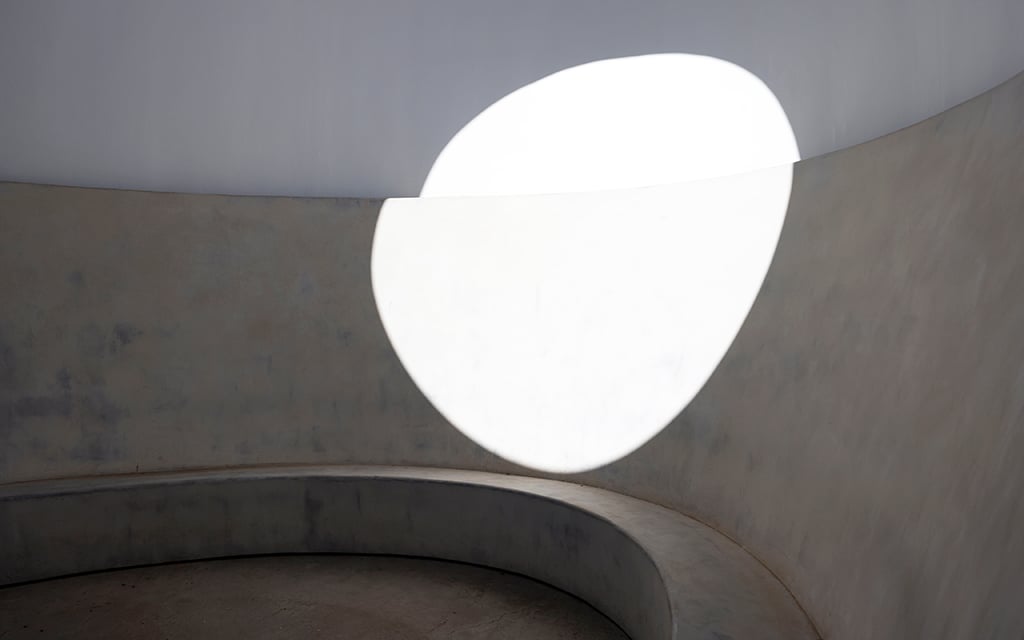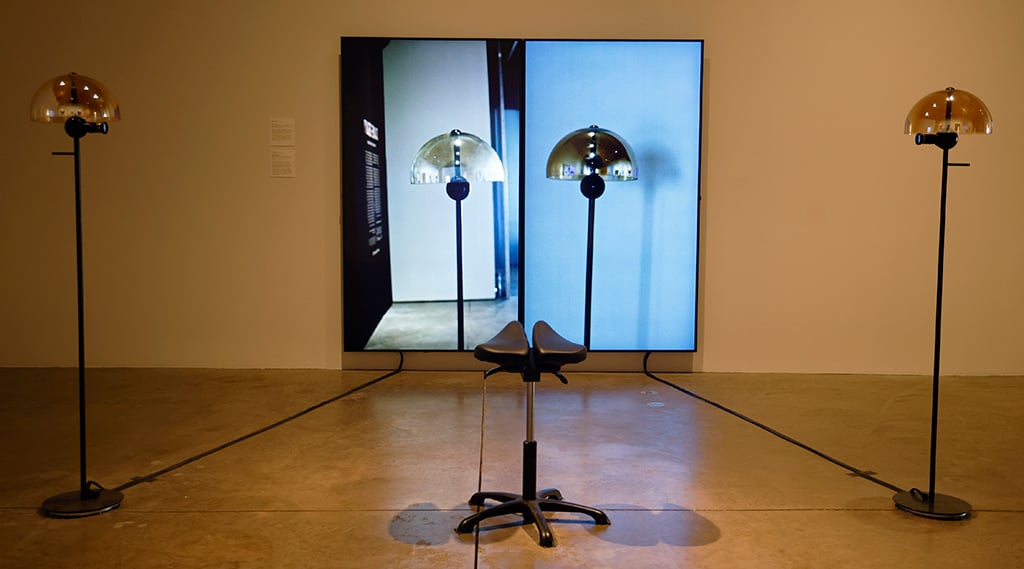
The “Exploding Native Inevitable” exhibit at the Scottsdale Museum of Contemporary Arts includes several still and interactive installations from 12 Indigenous artists and two collaboratives. Photo taken in Scottsdale on Wednesday, Sept, 18, 2024. (Photo by Gabriel Garza/Cronkite News)

The Entertainment 718 exhibit runs through Feb. 23 in the Scottsdale Museum of Contemporary Arts’ (blank) space gallery used for experimental art. Photo taken in Scottsdale on Sept. 18, 2024. (Photo by Gabriel Garza/Cronkite News)

“Knight Rise” by James Turrell is a dome with a hole in the top, using natural light to highlight a singular section. Photo taken in Scottsdale on Sept. 18, 2024. (Photo by Gabriel Garza/Cronkite News)
PHOENIX – Arizona changes every day. The state’s count of new buildings and people grows daily. As the state changes, so do the museums, which are challenged by a constantly changing city with new possibilities, tastes and people.
Museums in Arizona continue to change their tactics to draw in new audiences. These attractions are expensive to run but must continue to innovate what they have. Otherwise they risk the chance of losing their core audience.
Southern Arizona Museum of Science and Technology faces challenges
For the Scottsdale Museum of Contemporary Art, or SMoCA, and Phoenix Art Museum, their hard work has paid off. However, the Southern Arizona Museum of Science and Technology is struggling to remain afloat amid a decline in visitors. With the danger of closure on the horizon, the museum continues to test new attractions in hopes that tourism will rise.
The science and technology museum began operating May 4 in Sierra Vista. In a Facebook post dated Aug. 30, the owner and curator of the museum, Ron Hyde, thanked visitors for a summer with heavy foot traffic through the museum.
Hyde also informed followers that he was thinking of closing the museum due to the costs of operation and the lack of visitors in August.
Hyde gained interest in paleontology when he began collecting fossils when he was 5.
“I started collecting fossils, and it got to the point where my house was just full of fossils,” he said. “At some point, we decided we needed a museum to house these things.”
According to Hyde, the museum had an average of 1,000 visitors from May through July, or about 11 people per day. As of Aug. 1, the museum averaged 1.5 visitors each day since its primary audience, children, started school that month.
The museum lost 90% of its business in the space of a month. It has held several events throughout that time. In August, the museum’s field trip to the Lehner Mammoth Kill Site, about 20 minutes away, was attended by 32 people. In September, it held a bug camp that was attended by approximately 40 children and 20 adults, according to Hyde.
“We know that we have to, that we have to have people coming in from other areas for sure. Tourism is very important,” Hyde said. He wants to attract more visitors from metropolitan areas in Arizona, such as Phoenix and Tucson.
It’s a free museum; however, there is a suggested donation of $10 per adult, $5 per child or $8 for military and seniors. In addition, the museum participates in the Museums for All program, which ensures those who receive food assistance, known as SNAP benefits, can receive free or reduced admission to over 1,300 museums across the U.S. The museum suggests $3 donations from program participants.
The museum is staffed by volunteers. Hyde has received several thousand dollars in donations over the past year, but it is not enough to cover the yearly cost of the $30,000 required to run the museum.
Hyde said he spends an average of $500 on advertising a month. He advertises his museum through the local newspaper, the Herald/Review, and the radio station, K101.
The decision to close is not final yet, and Hyde said he is considering all options, including working on getting the museum a 501(c)(3) status. That would allow him to apply for more grants.
Phoenix Art Museum revolutionizes exhibitions, space
Unlike the science and technology museum, the Phoenix Art Museum is planning for a new direction, according to Jeremy Mikolajczak, director and CEO of Phoenix Art Museum
He said he understands the changes in the Phoenix metro area and how they affect the museum. He talked about a new direction for the museum, which has been cultivating artworks and stories for Arizonans since 1959.
“We know that the art on the walls isn’t the only driving force,” Mikolajczak said. “You need good services on site. We want to go and enjoy a day at the museum. So, of course, that includes dining and other things. We want to be engaged in other sorts of art that may be, not necessarily physical.”
With the museum’s 65th birthday on the horizon, Mikolajczak continues to think to the future with the business’ strategic plan that highlights a six-year construction timeline to 2030.
“We really want to be community focused,” Mikolajczak said. “We really want to know what people want to see, what they want to explore. What are those areas that we don’t have representation in that we need to make sure that we are following through on those sort of plans to make sure that everyone is seen in this space.”
The plan highlights new attractions, such as original exhibitions, digitizing past exhibitions for optimal viewing, gallery renovations, a new restaurant and more. Planning began in spring 2023, according to Mikolajczak.
“It’s an action-driven plan,” Mikolajczak said. “(We thought,) let’s dial in and really think about the strategies and the steps we want to take, the changes we want to have at this museum, the impact we want to have in those communities, as well as what are our goals at the end of this plan?”
Mikolajczak said a museum must function as a community center, and he wants to make it a space of engagement for patrons and make people feel welcome and comfortable. He said people with families may not think the museum is a place for them based on the current activities available at the museum.
The strategic plan keeps families in mind, and the innovations are done with the intention of drawing more diverse patrons to the museum: families, food lovers and others.
“We really wanted to break down that barrier as much as possible. Art is really for everyone,” Mikolajczak said. “There’s really something for everyone in this space, in this building, in terms of how you respond to something or what you enjoy, where you find beauty, and where you find wonder.”
According to Mikolajczak, the museum is tracking the same number of visitors as it was prior to the pandemic due to an increase in diverse exhibitions, such as “Barbie: A Cultural Icon.”
Mikolajczak said the character already had an established notoriety in the history of fashion, which drew more visitors to the museum.
SMoCA focuses on partnerships, innovative artwork
SMoCA is focusing on diversity, community engagement and partnerships with neighboring museums.
“I want to be presenting things that really resonate with our community, that provide opportunities for artists, that show visitors to the area that there’s something more than resorts and swimming pools,” said Jennifer McCabe, director and chief curator of SMoCA. The museum opened in February 1999. The building itself formerly stood as a movie theater before it was reconstructed by Phoenix architect Will Bruder. The museum is funded primarily from admission, donations and funds provided by nonprofit Scottsdale Arts.
In 2017, Squidsoup, a collective, brought an exhibition to SMoCA using light-based data visualization to create an augmented reality environment. The exhibition was a hit for SMoCA, according to a press release from the museum, drawing in nearly 49,000 attendees throughout its time at the museum.

Chando Ao’s “Mirror 4” installation is part of the “Brains and Beauty” exhibition at the Scottsdale Museum of Contemporary Arts. It shows a person’s point of view from the side while sitting in between two cameras. Photo taken in Scottsdale on Sept. 18, 2024. (Photo by Gabriel Garza/Cronkite News)
“A thousand people were coming through the door on any given day,” McCabe said. “It was more than four times what we were used to on an annual average of attendance. That was a surprise. In some ways, because the size of our museum is small, we can respond to those kinds of events.”
After the Squidsoup exhibition, SMoCA began to focus on new media and technology. McCabe said that an exhibition can take a varying number of years to construct, which depends on the size of the installation.
The museum is working on an exhibition titled “transfeminisms” that will open next spring and will take over the entire museum.
“Usually, we’ve planned out in the museum space, all of our shows at least two or four years ahead,” McCabe said. “So, we’re working on what’s next, what comes next spring, fall and a few years from now. We’re always operating in different years, sometimes I forget what year it is because we’re talking about next year.”
SMoCA sometimes acquires work from exhibitions and houses them off-site. The collection, according to McCabe, holds approximately 2,000 artworks.
“Museums have historically been white spaces, and they have supported predominantly white male artists,” McCabe said. “We don’t discriminate against any artist, but we try to bring some equity to the field. And in order to bring equity to the field, you have to raise up other voices, right? So, we spend a lot of time raising up those other voices.”

“The Creative Mind” installation is part of the “Brains and Beauty” exhibit offered until Jan. 19 at the Scottsdale Museum of Contemporary Arts. Photo taken in Scottsdale on Wednesday, Sept. 18, 2024. (Photo by Gabriel Garza/Cronkite News)
McCabe said that when making decisions about which exhibitions to showcase in the museum, how it will be received by the audience is paramount.
“We try to analyze,” McCabe said. “We spend a lot of time analyzing our attendance and trying to figure out what people are enjoying or not enjoying – what makes them calm or not calm.”
According to Sydney Ritter, SMoCA’s senior communication specialist, the museum was at a high for attendance when the COVID-19 pandemic hit. Since then, it has been slowly returning to pre-pandemic numbers.
The best way for the museum to advertise, McCabe said, is through its partnerships. Current exhibition “Brains and Beauty: At the Intersection of Art and Neuroscience” was done through a partnership with the Barrow Neurological Institute.
“They made the animations for us, and we loaned artworks to their facility in central Phoenix,” McCabe said. “That was a way for us to promote what we’re doing here in our space.”
Audiences that are not typically reached by SMoCA can be reached through partnerships with other art collectives, according to McCabe. She said the museum has a limited budget for advertising because most of the budget goes toward the exhibitions.
According to Ritter, SMoCA, on average, garners 25,000 visitors each year.
SMoCA will advertise one of its own exhibitions, “Exploding Native Inevitable,” at the Heard Museum with postcards McCabe will take to the exhibition when it begins this fall. In turn, the Heard Museum will advertise its exhibition at SMoCA.

